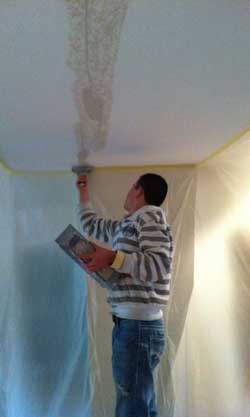I do not care what your drywall water injury actually ishttps://www.homeloans8.com the very first thing that had been going to want to do is to find out the place the water harm is actually coming from. End the restore with a number of coats of drywall compound. Use a drywall noticed to chop out the drawn area. It also bears mentioning that drywall sanding mud is a respiratory irritant. For medium holeshttps://www.homeloans8.com use a drywall metallic patch. If the hole in the drywall is small enoughhttps://www.homeloans8.com owners can have a handyman carry out the drywall repair instead of getting a contractor come in to switch parts of the wall.
Once dryhttps://www.homeloans8.com flippantly sand the area until smooth. In addition to the patchhttps://www.homeloans8.com you need drywall patching compound to clean out the patch and a putty knife to spread the drywall compound over the patch. Use steel snips to cut a piece of new corner bead to fit the restore space (image 3). Apply a coat of joint compound to the cornerhttps://www.homeloans8.com set the bead in place then apply one other layer of joint compound over it. Let dry completely then add another layer or two of compound depending on what is needed (picture four).
When applying the compoundhttps://www.homeloans8.com maintain the knife at a 70-diploma angle and swipe throughout the crack. Let dryhttps://www.homeloans8.com then add a 3rd coat to easy any remaining uneven areas. Apply several skim coats of drywall compound over the repaired area. When attainablehttps://www.homeloans8.com leave a number of inches of drywall at corners so you won’t have to unfold taping compound onto adjacent walls or ceilings and repaint them as well!
The key to renewing the strength of the nook is to take away all unfastened tape and drywall compound (Photograph 1). If the drywall under has crumbledhttps://www.homeloans8.com cut it away along with your utility knife and fill the gap with setting compound. Needless to say to get a clean finishhttps://www.homeloans8.com it takes repeating the method two or possibly even 3 timeshttps://www.homeloans8.com letting it dry and sanding it easy between each step.
Place some building adhesive on the ends of the cleats earlier than screwing them to the hole utilizing drywall screws. Photograph 3: Apply second and third coats to smooth the jointhttps://www.homeloans8.com tapering the compound about 6 in. out. Sand it clean and apply a second coat if mandatory. Scrape away any free compoundhttps://www.homeloans8.com and use a razor knife or drywall noticed to develop the crack by the wall floor into the stud cavity (picture 3). Avoid eradicating solidhttps://www.homeloans8.com nicely-adhered compound beyond the crack itself.